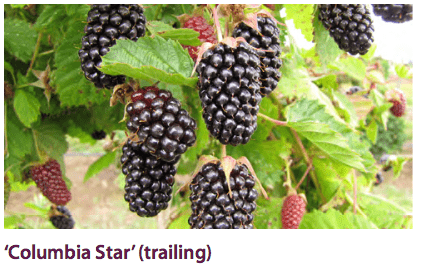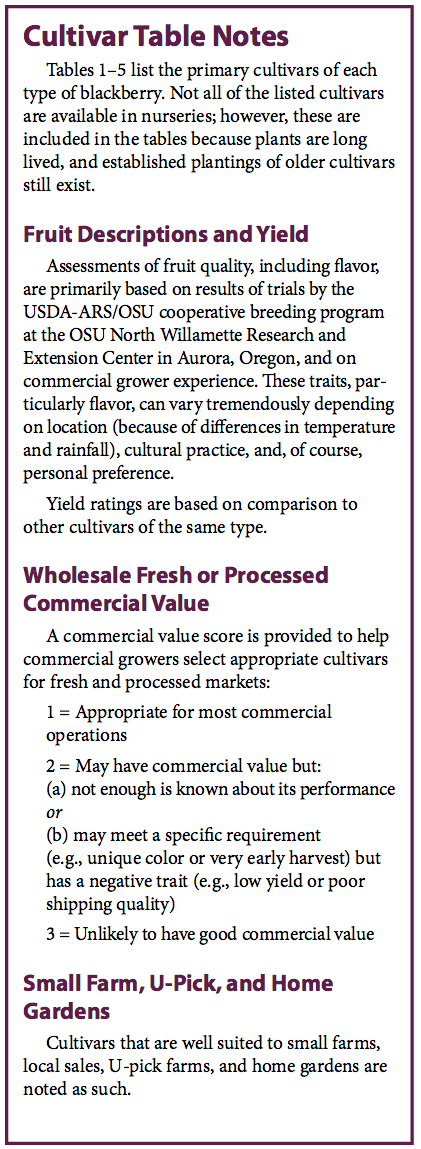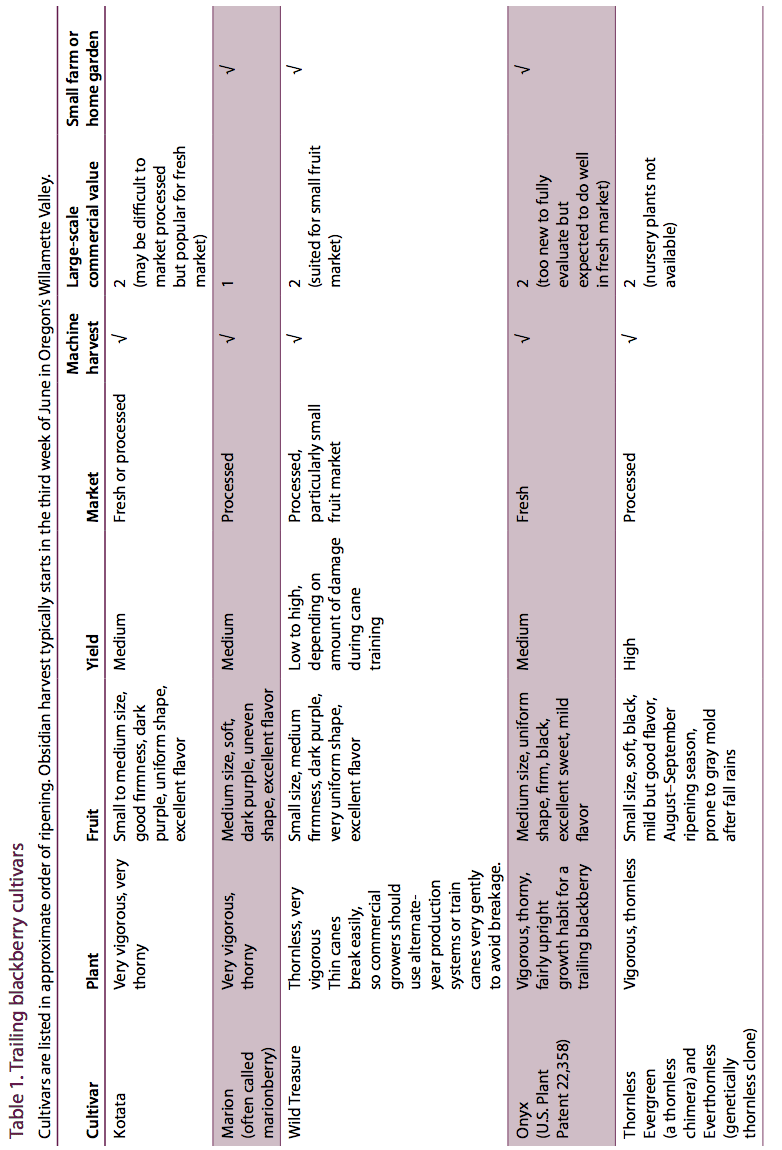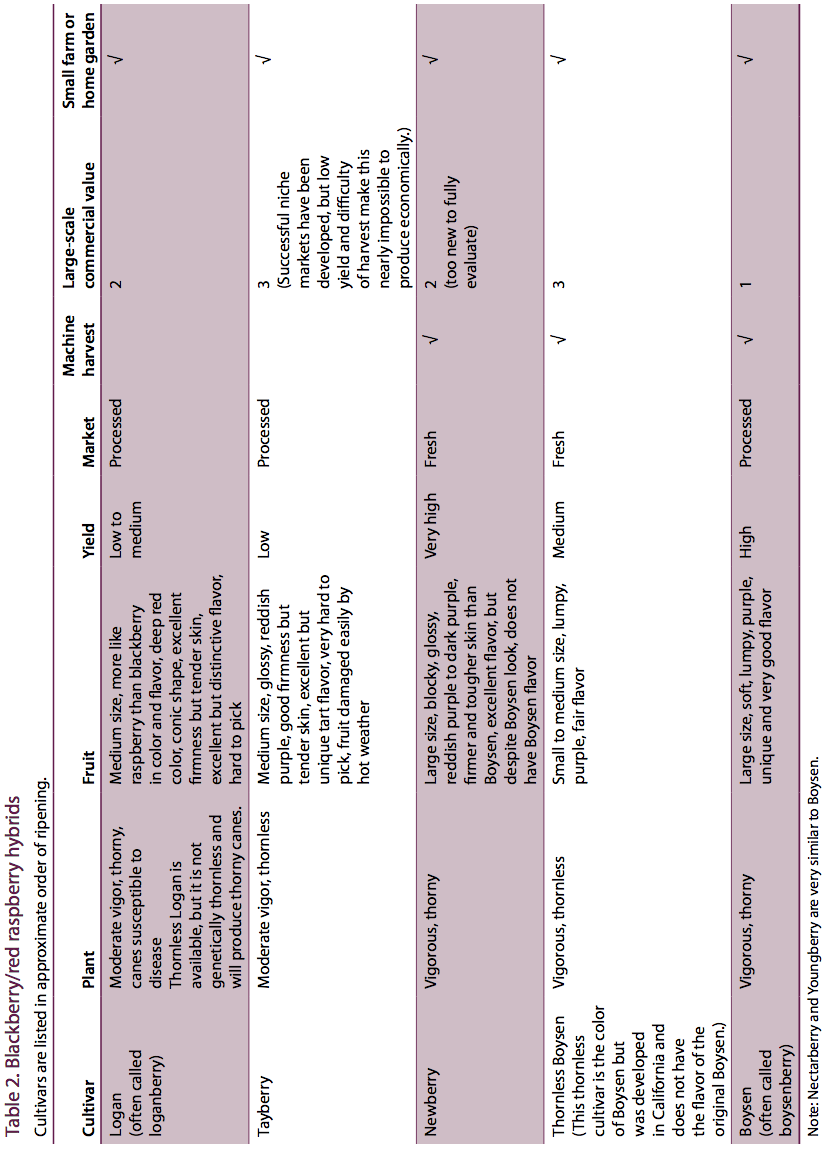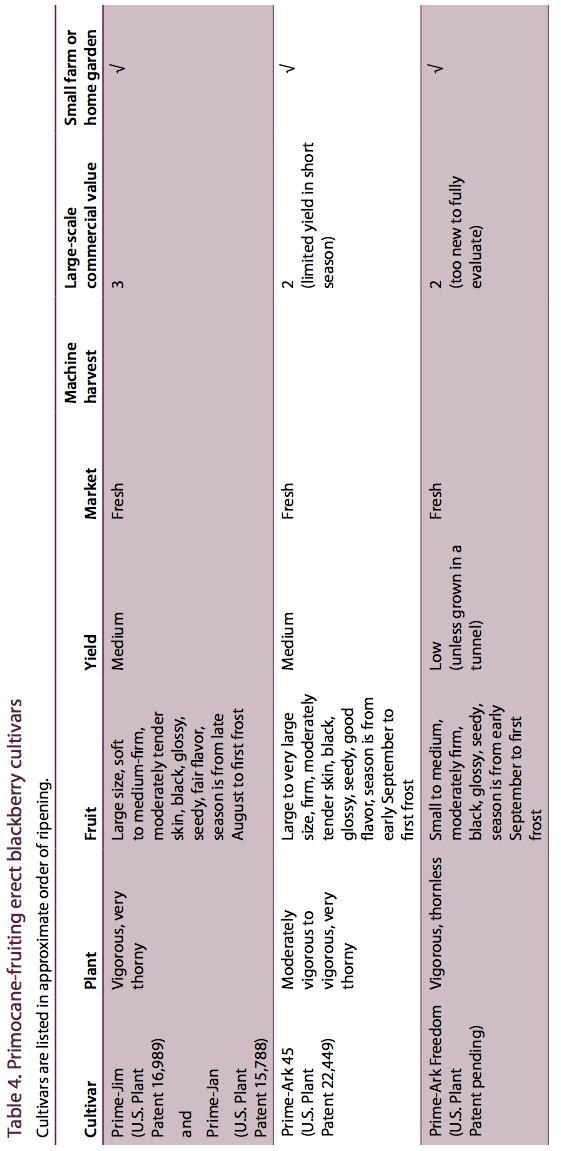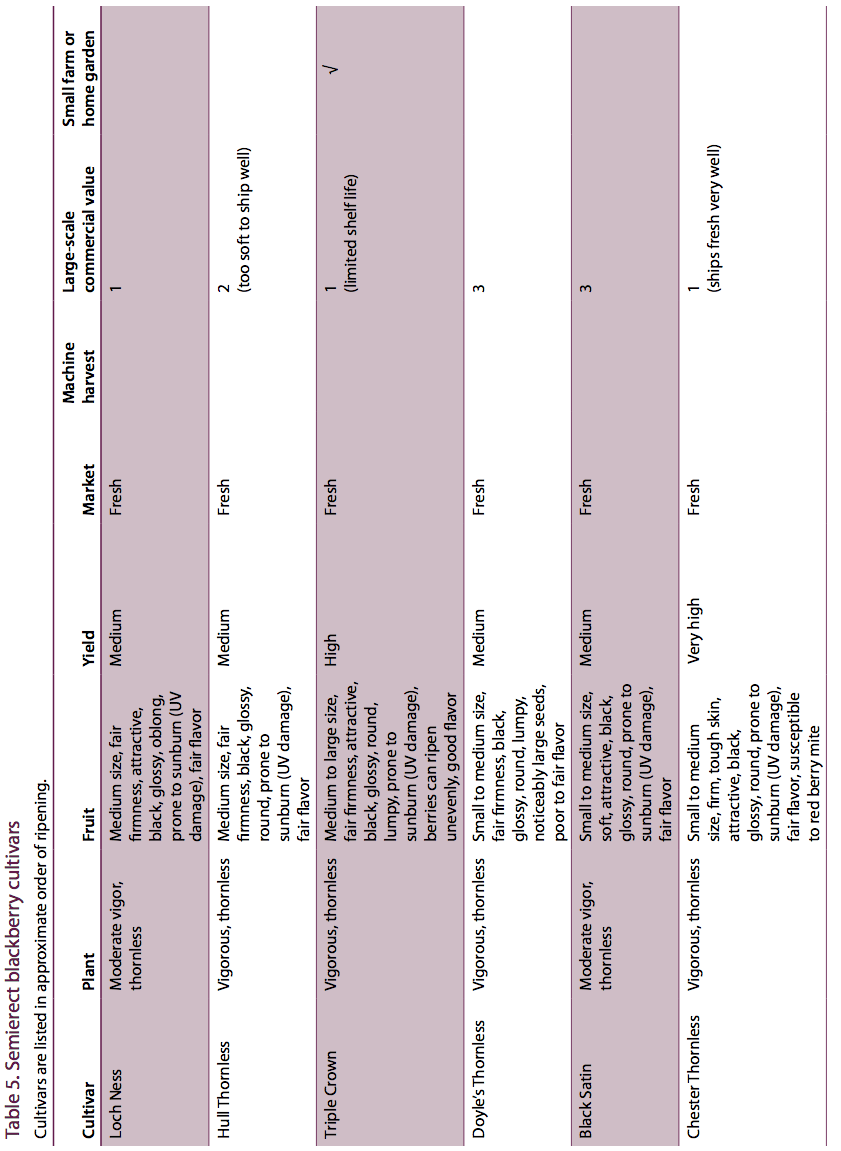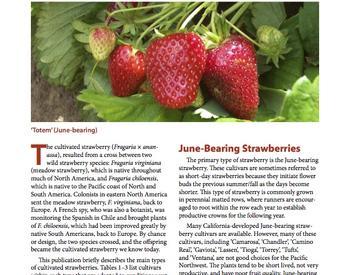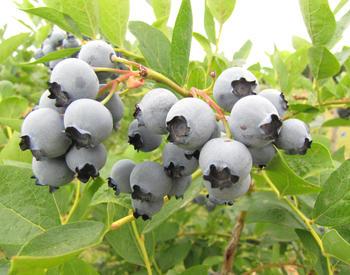There are three main types of blackberries grown in Oregon: trailing, erect, and semierect. Several hybrids between raspberry and trailing blackberry have been developed, including ‘Logan’, ‘Tayberry’, and ‘Boysen’ blackberries. Since these grow like a trailing blackberry, they need to be managed in the same way.
This publication briefly describes each type of blackberry. Tables 1–5 list the primary cultivars in approximate order of ripening within each type.
Trailing Blackberries
The main species in the background of the trailing blackberry is Rubus ursinus, which is native along the Pacific Coast from British Columbia to California, and inland to Idaho. Trailing blackberries produce vigorous primocanes (first-year, vegetative canes) from the crown (base) of the plant. Primocanes trail along the ground and may grow to 20 feet long. Primocanes are produced only from the crown, not from roots, so this type of blackberry is less invasive than many others. Plants need a trellis for support.
Second-year canes, known as floricanes, produce fruit. In general, trailing blackberries produce berries that have a long shape; relatively small seeds; and highly aromatic, intense flavor.
In Oregon, fruit ripens from mid-June to August, depending on the cultivar. The fruiting season for each cultivar lasts about 4 weeks.
Trailing blackberries are considered the least cold hardy of the three types of blackberries. Expect damage to buds and canes when temperatures drop below about 13°F in December or early January. Plants are even more sensitive to cold in late fall and late winter, when damage might occur at much warmer temperatures (in the 20s). Trailing blackberries grow well west of the Cascades in Oregon and southern Washington, although some damage might occur in particularly cold winters.
A second species of trailing blackberry, Rubus laciniatus (the cutleaf or evergreen blackberry), was imported from Europe in the late 1800s. This species was once an important industry in Oregon but has now declined. ‘Evergreen’ and another introduced species from Europe, ‘Himalaya’ (Rubus armeniacus, syn. R. procerus), have naturalized throughout much of the Pacific Northwest and are considered noxious weeds.
Trailing blackberry cultivars are listed in Table 1.
Blackberry/Red Raspberry Hybrids
These hybrids generally have been developed unintentionally. Most have been found in plots or in the wild where red raspberry has been grown with R.ursinus blackberry. Despite their purple-to-red fruit color, they are technically blackberries because the receptacle (white core) is part of the fruit when it is picked. (In red raspberries, the receptacle stays on the plant.)
These hybrids are considered trailing blackberries because of their growth habit. While ‘Boysen’ and ‘Logan’ historically have been very important in the commercial industry, commercial acreage of these hybrids has declined steadily. ‘Tayberry’ is another hybrid that is sold occasionally.
Blackberry/red raspberry hybrids are listed in Table 2.
Erect Blackberries
These blackberries were developed from a very different eastern native blackberry species. Erect blackberries produce stiff, upright canes that may grow to 12 feet in Oregon, if left unpruned. Plants can colonize an area by producing new primocanes (suckers) from the roots. Plants form a hedgerow and need a trellis for support. Prune or tip primocanes in summer to encourage branching and increase fruit production on the second-year floricanes.
Erect blackberries produce fruit with relatively large seeds. Flavor and aroma are not considered as intense as in many of the trailing blackberry cultivars. Although many erect blackberries taste good, berries often have a “grassy,” “green,” or bitter flavor that some people don’t like. These berries are commonly grown for the fresh market, as the berries are firmer than those of most trailing types. In Oregon, fruit ripens from early July to August.
Erect blackberry cultivars are listed in Table 3.
Primocane-Fruiting Erect Blackberries
These blackberries produce fruit on the tips of the primocanes or on primocane branches. This characteristic makes management easier, as the canes can be cut to the ground in the dormant season, and fruit is produced from September through October, depending on the climate. Tip primocanes in summer to encourage branching.
Primocane-fruiting blackberries will produce a floricane crop the following year on the part of the cane that did not fruit the previous fall; however, we recommend growing these cultivars only for a fall crop. See the OSU Extension publication Growing Blackberries in Your Home Garden (EC 1303) for more information.
Primocane-fruiting erect blackberry cultivars are listed in Table 4.
Semierect Blackberries
These plants are thornless and produce very vigorous, thick, erect canes from the crown. The canes grow up to 20 feet long and arch to the ground if left unpruned. Primocanes are not commonly produced from the roots. Prune primocanes in summer to encourage branching and increase fruit production on the second-year floricanes. Canes require a trellis for support.
Semierect blackberries generally produce a higher yield than trailing or erect types. Fruit quality is similar to that of erect blackberries. In Oregon, fruit ripens from late July to early October, depending on the cultivar. The introduced weed ‘Himalaya’ has a growth habit most similar to the semierect types.
Semierect blackberry cultivars are listed in Table 5.
This information is provided for educational purposes only. If you need legal [or tax] advice, please consult a qualified legal [or tax] adviser.
Trade-name products and services are mentioned as illustrations only. This does not mean that the Oregon State University Extension Service either endorses these products and services or intends to discriminate against products and services not mentioned.
Use pesticides safely!
- Wear protective clothing and safety devices as recommended on the label. Bathe or shower after each use.
- Read the pesticide label—even if you’ve used the pesticide before. Follow closely the instructions on the label (and any other directions you have).
- Be cautious when you apply pesticides. Know your legal responsibility as a pesticide applicator. You may be liable for injury or damage resulting from pesticide use.
© 2017 Oregon State University
Extension work is a cooperative program of Oregon State University, the U.S. Department of Agriculture, and Oregon counties. Oregon State University Extension Service offers educational programs, activities, and materials without discrimination on the basis of race, color, national origin, religion, sex, gender identity (including gender expression), sexual orientation, disability, age, marital status, familial/parental status, income derived from a public assistance program, political beliefs, genetic information, veteran’s status, reprisal or retaliation for prior civil rights activity. (Not all prohibited bases apply to all programs.) Oregon State University Extension Service is an AA/EOE/Veterans/Disabled.

